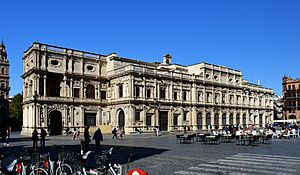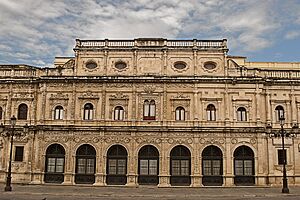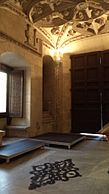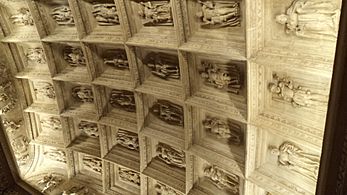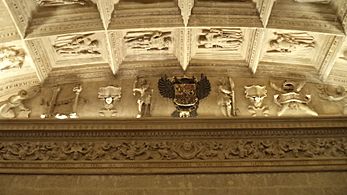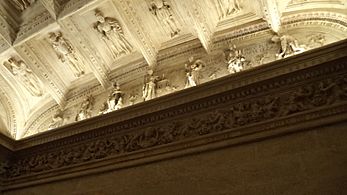Seville City Hall facts for kids
The Seville City Hall (which in Spanish is called Casa consistorial de Sevilla) is a special building in Seville, Spain. It's where the city's government meets to make decisions. The building is famous for its unique style called Plateresque, which means it has lots of detailed carvings that look like silverwork.
The front of the building is very grand. It has many sections covered with these detailed carvings. You can see symbols like coats of arms, pictures that represent Justice and Good Government, and even famous characters. Look closely and you might spot Hercules, Julius Caesar, and Charles V carved into the stone!
Contents
History of Seville City Hall
In 1526, something big happened in Seville: Emperor Charles V got married there. After this important event, people felt the city needed a grander building for its government. It was important to show how powerful and important Seville was at that time.
Building the First City Hall
Before the new building, the city council met in older houses. The new City Hall was planned for a busy central square called Plaza de San Francisco. This was a perfect spot, right in front of a big convent.
Work on the building started in 1527. A talented architect named Diego de Riaño was in charge. He worked on it until he passed away in 1534. His job was to create a strong stone building. He designed the part of the City Hall that faces Plaza de San Francisco. This section has amazing Plateresque carvings. These carvings show historical figures, mythical characters, and symbols related to the city's founders.
Expanding the City Hall
Later, in the 1800s, the old convent next door was taken down. This allowed the City Hall to get much bigger. Architects Demetrio de los Ríos and Balbino Marrón led this expansion. They added a new front to the building, facing a different square called Plaza Nueva. This new part was built in a different style, called Neoclassical.
The architects tried to add some of the old Plateresque carvings to the new section. But they never finished all the detailed work. Today, it's very hard to change or finish old buildings like this because they are protected as important historical sites. Inside, the architects also redesigned the building. They added two courtyards and a grand staircase.
Exploring the City Hall Building
Outside the City Hall
Front Facing Plaza de San Francisco
This side of the building is very long and detailed. It has five main sections. It mostly has two floors, but some parts have a third. All these sections are covered in the beautiful Plateresque carvings. These carvings are full of life! You can see Italian-style grotesques (fancy, playful designs). There are also coats of arms and symbols about justice and good government.
Look closely for carvings of people important to Seville's history. You'll find Hercules, who is said to have founded the city. There's also Julius Caesar, who created the first city council. And, of course, Emperor Charles V, who made Seville a very important city in his empire. Many artists worked on these carvings, including Juan de Begines and Diego Guillén Ferrant.
There's an archway on this side that used to lead to the old convent. Now, it connects to Plaza Nueva. This archway was built by Juan Sánchez, who took over the work after Diego de Riaño.
Main Front Facing Plaza Nueva
The main front of the City Hall, which looks out onto Plaza Nueva, was finished in 1867. This part was designed by Demetrio de los Ríos and Balbino Marrón during the big expansion.
Inside the City Hall
Ground Floor
When you enter the City Hall, you'll find several important rooms on the ground floor:
- *Apeadero*: This is the entrance area. It used to be where people would get off their horses. It has a mix of old Gothic and Renaissance styles.
- *Antecabildo*: This room leads to the main staircase. The staircase has two parts, with a special domed ceiling.
- *Cabildo bajo* (Lower Chapter House): This room has a magnificent ceiling with carved images of kings. The walls are decorated with medallions and more detailed carvings.
- *Chamber of the Court*: This room is near the archway.
First Floor
The grand staircase leads you up to the first floor lobby. Here, you'll find more important rooms:
- *Library*: This is where many books are kept. From here, you can go into the upper chapter house.
- *Upper Chapter House*: This room has a beautiful wooden ceiling with carved panels. It also displays some very important paintings owned by the city. These include works by famous artists like Francisco de Zurbarán and Juan de Valdés Leal.
- *Columbus Hall* (also known as the Bourbon Hall): This room has portraits of kings and queens. Since 2008, this is where the city council holds its main meetings.
- *Gala Dining Room*: This room has portraits of people important to the city.
- *Archive*: This is where important historical documents are stored.
See also
 In Spanish: Casa consistorial de Sevilla para niños
In Spanish: Casa consistorial de Sevilla para niños


